WWII Allied Land Force Headquarters (LHQ) "Victoria - Sorrento" Australia Mainland Operations Map*
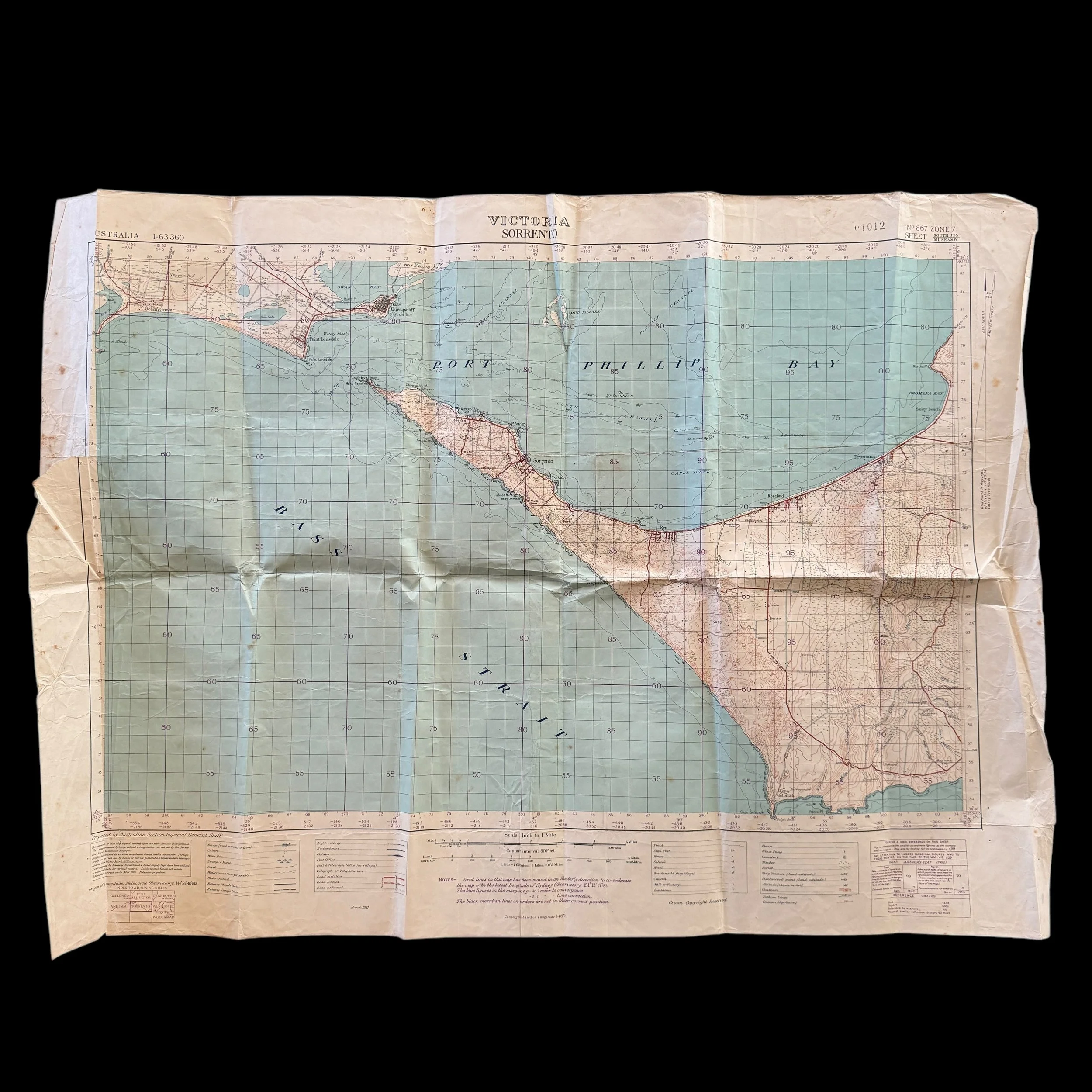

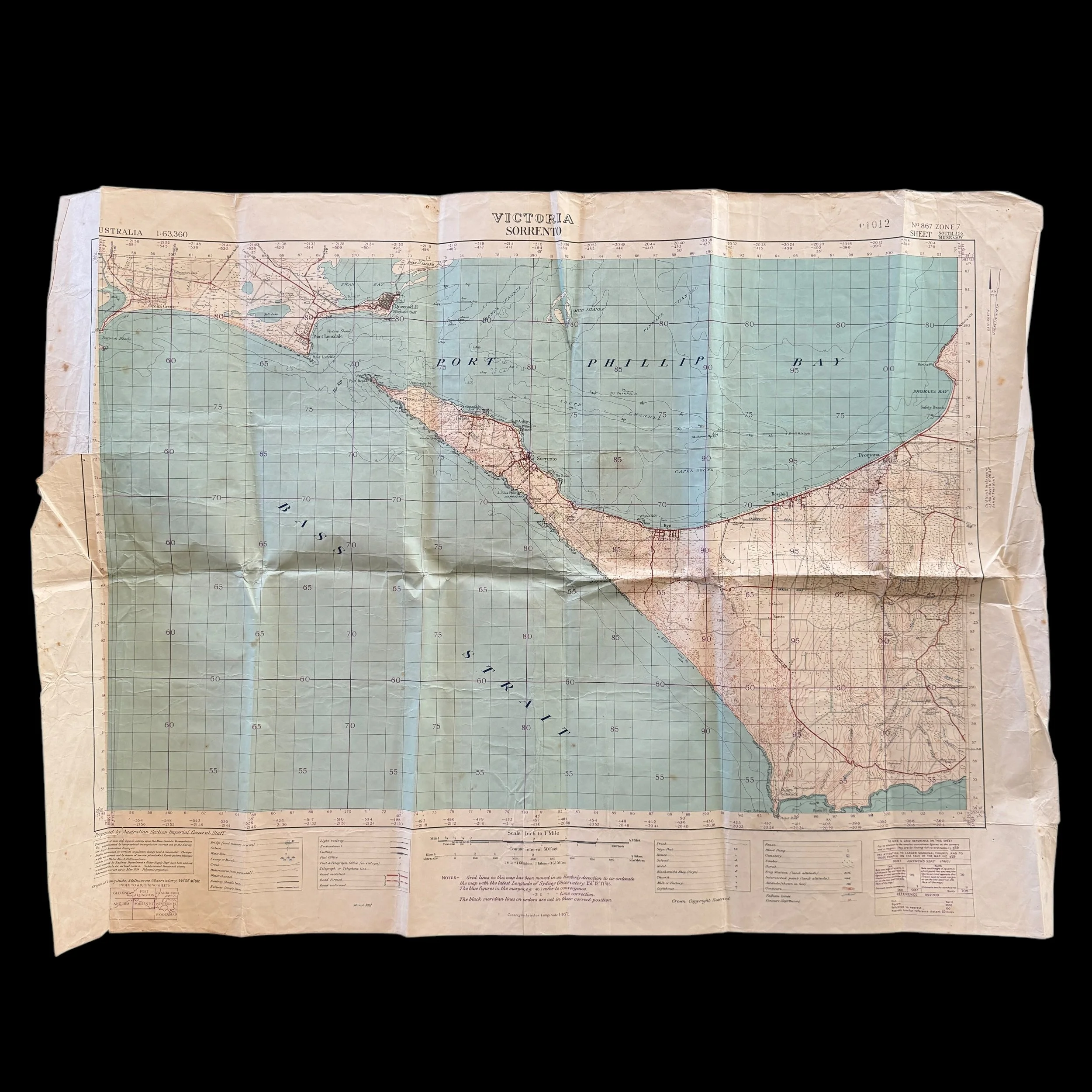
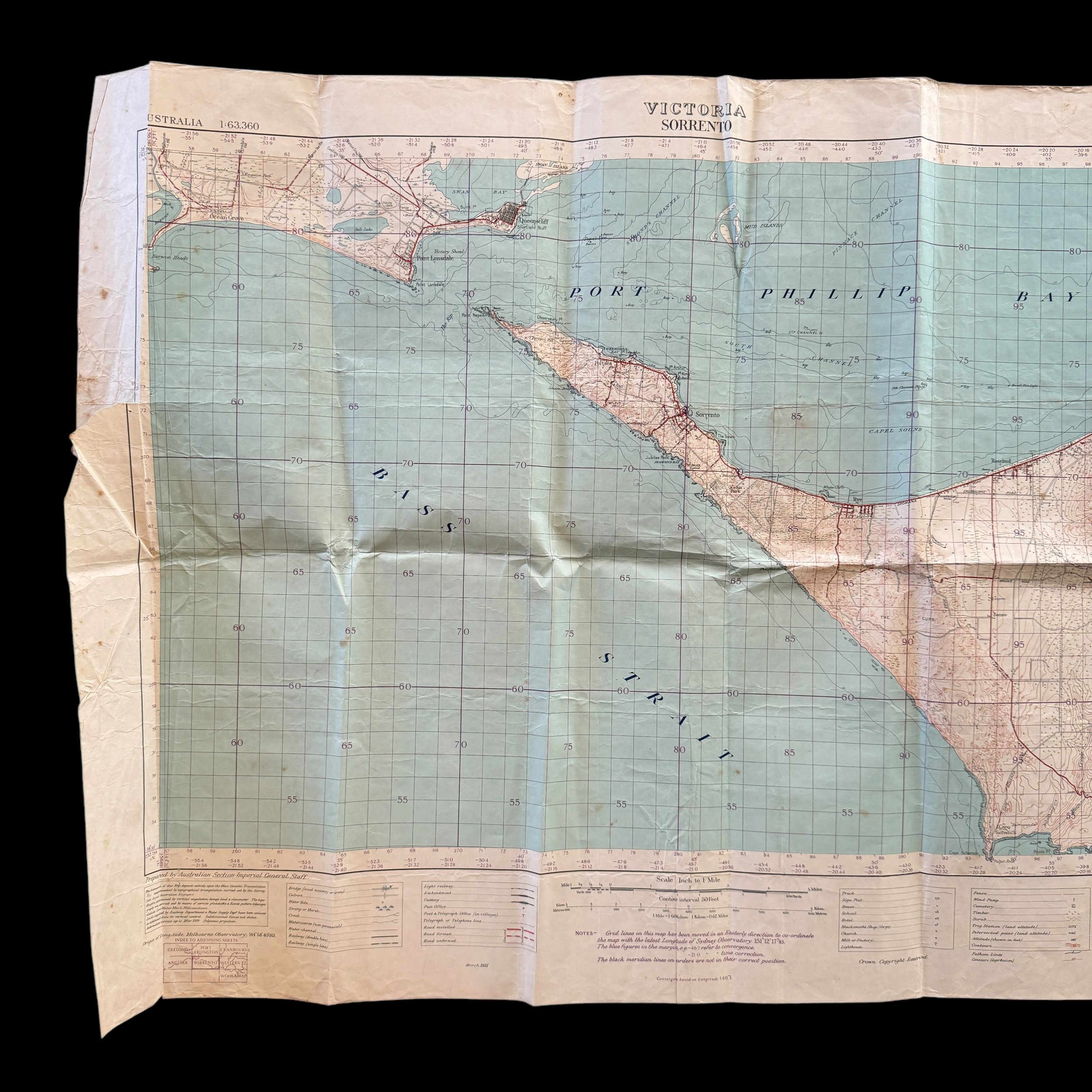
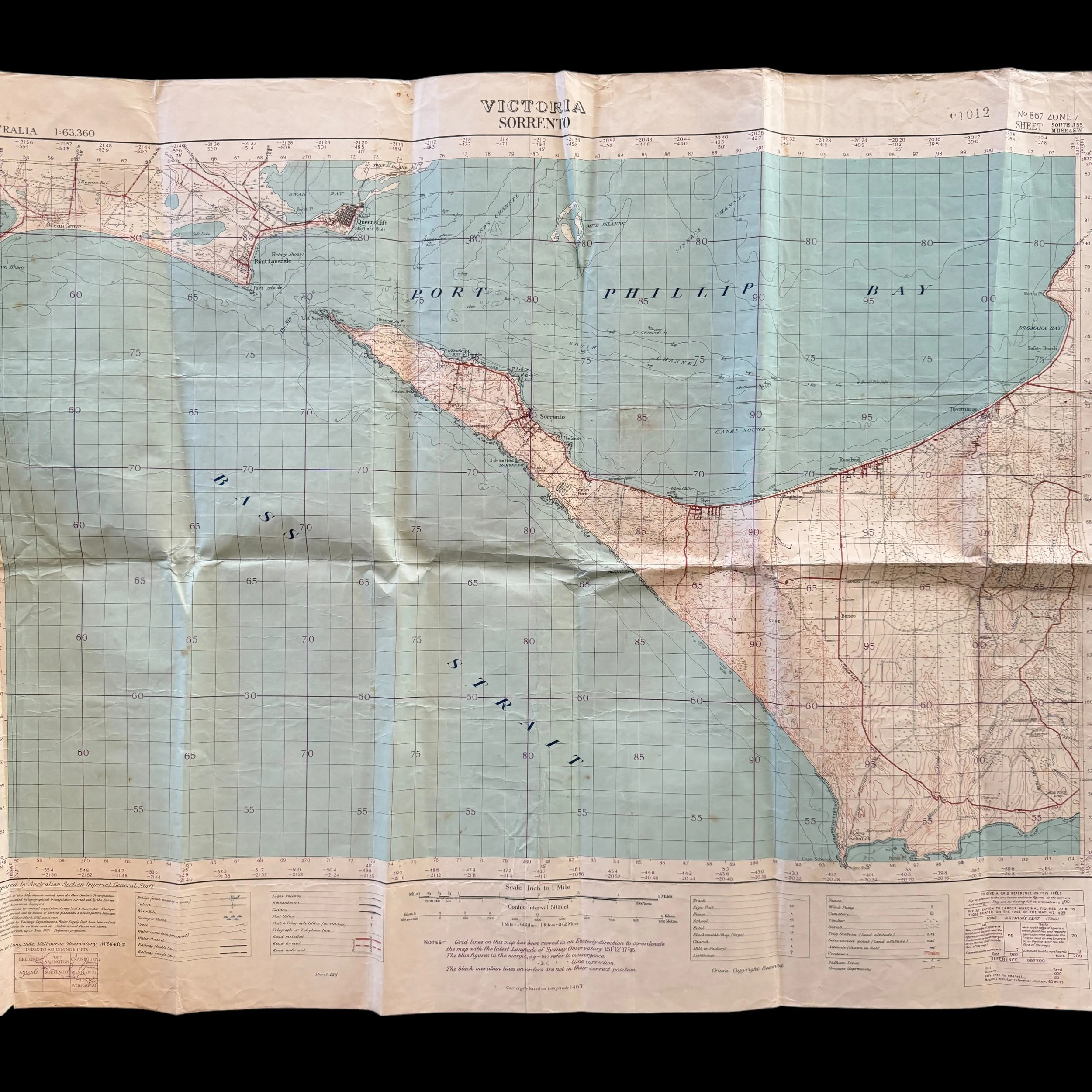
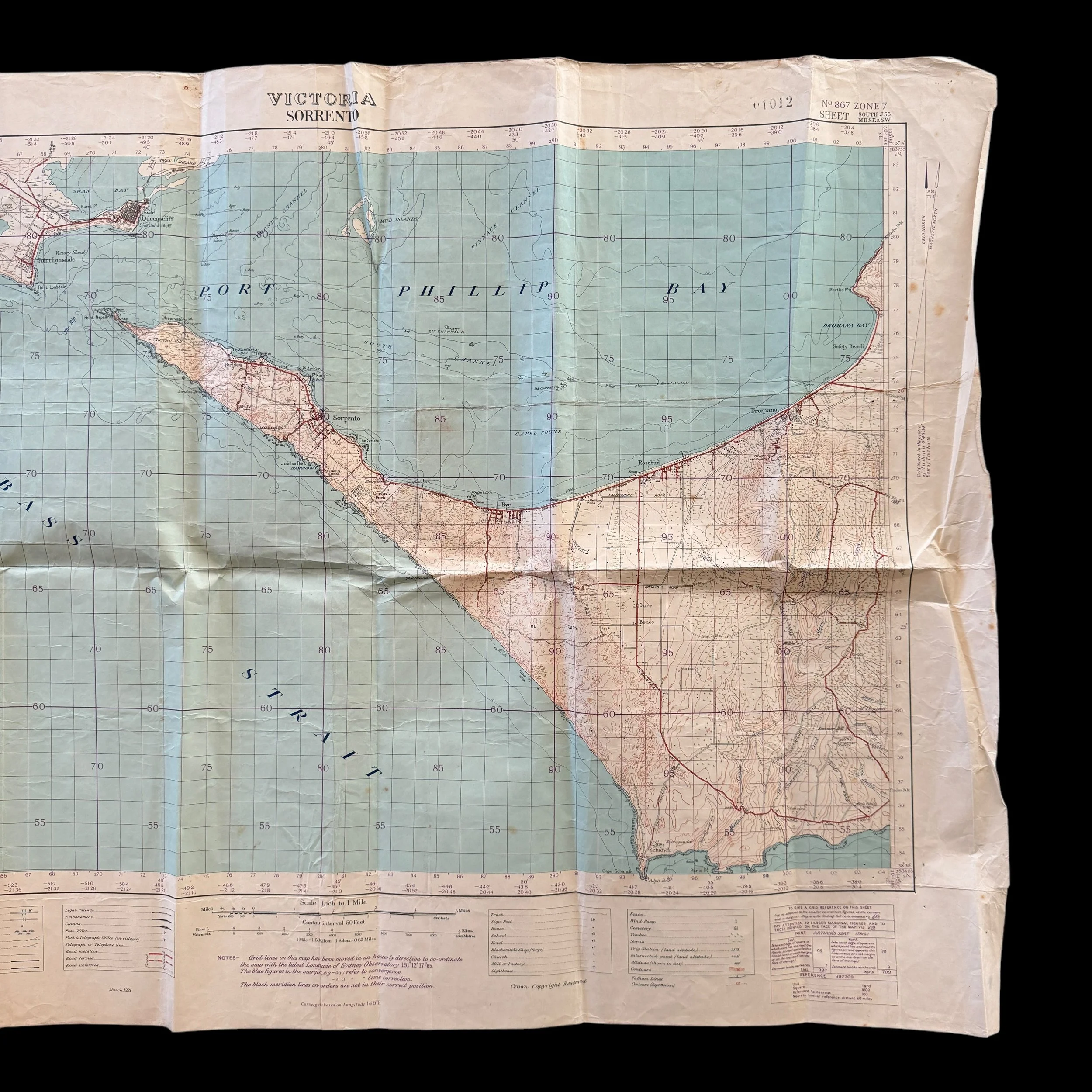
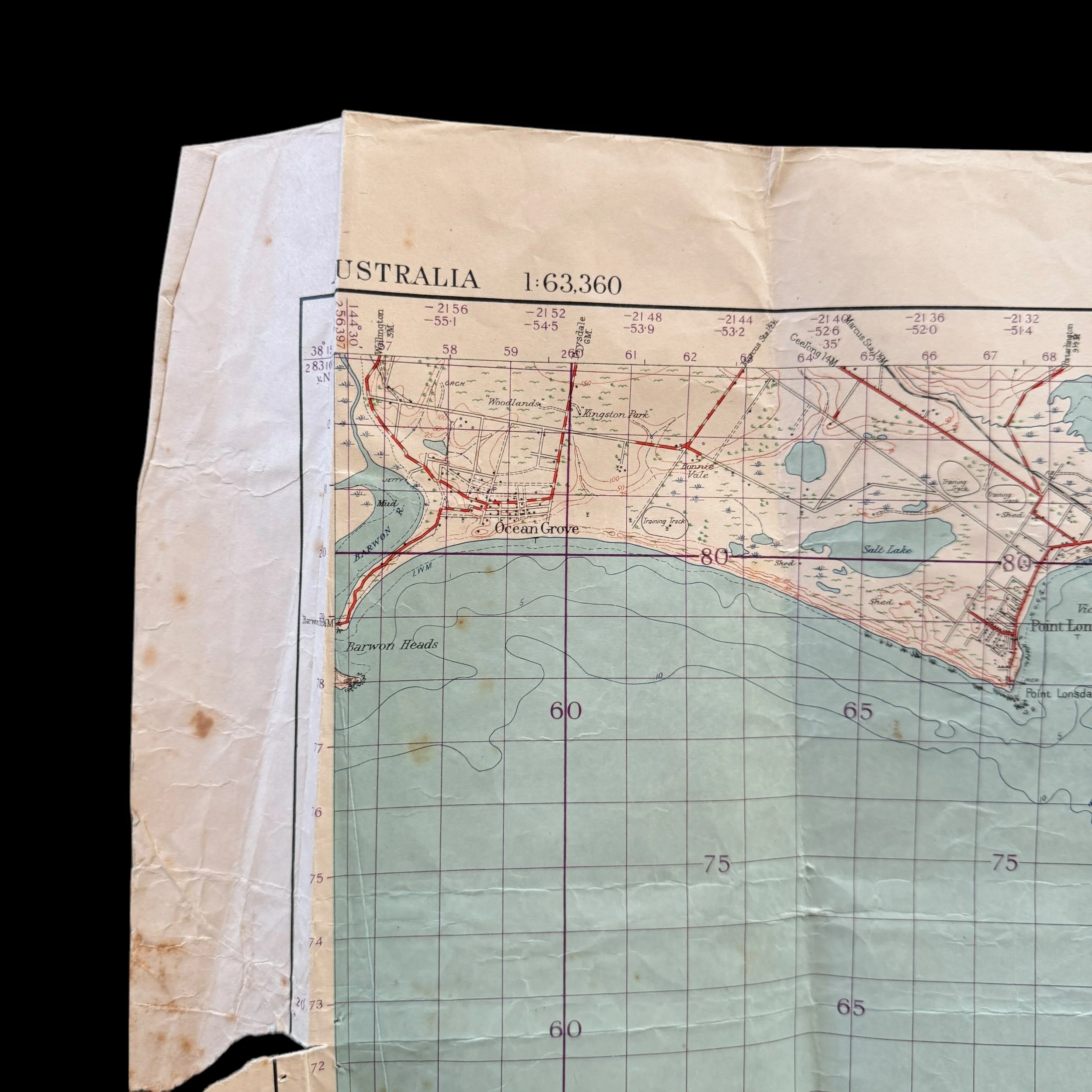

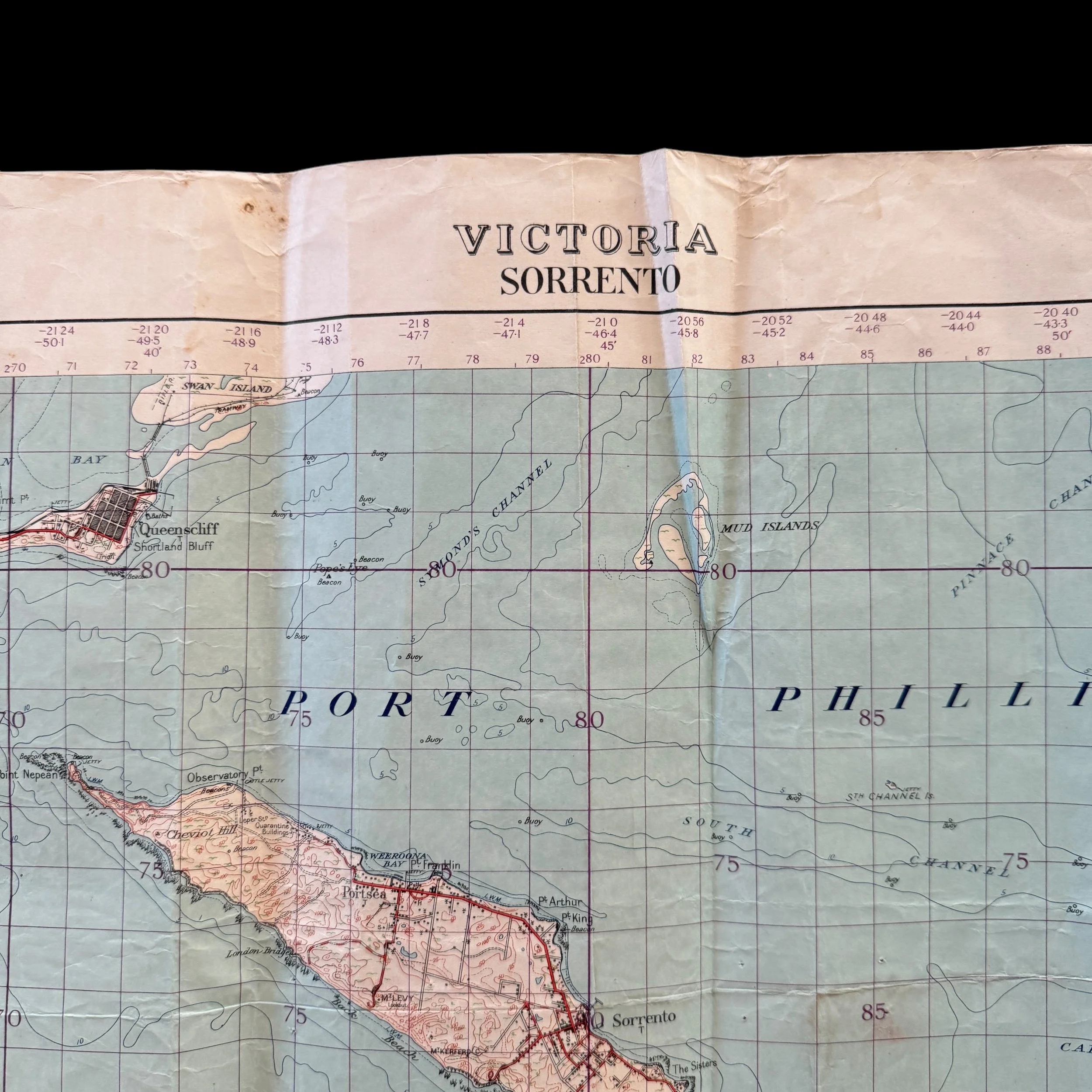
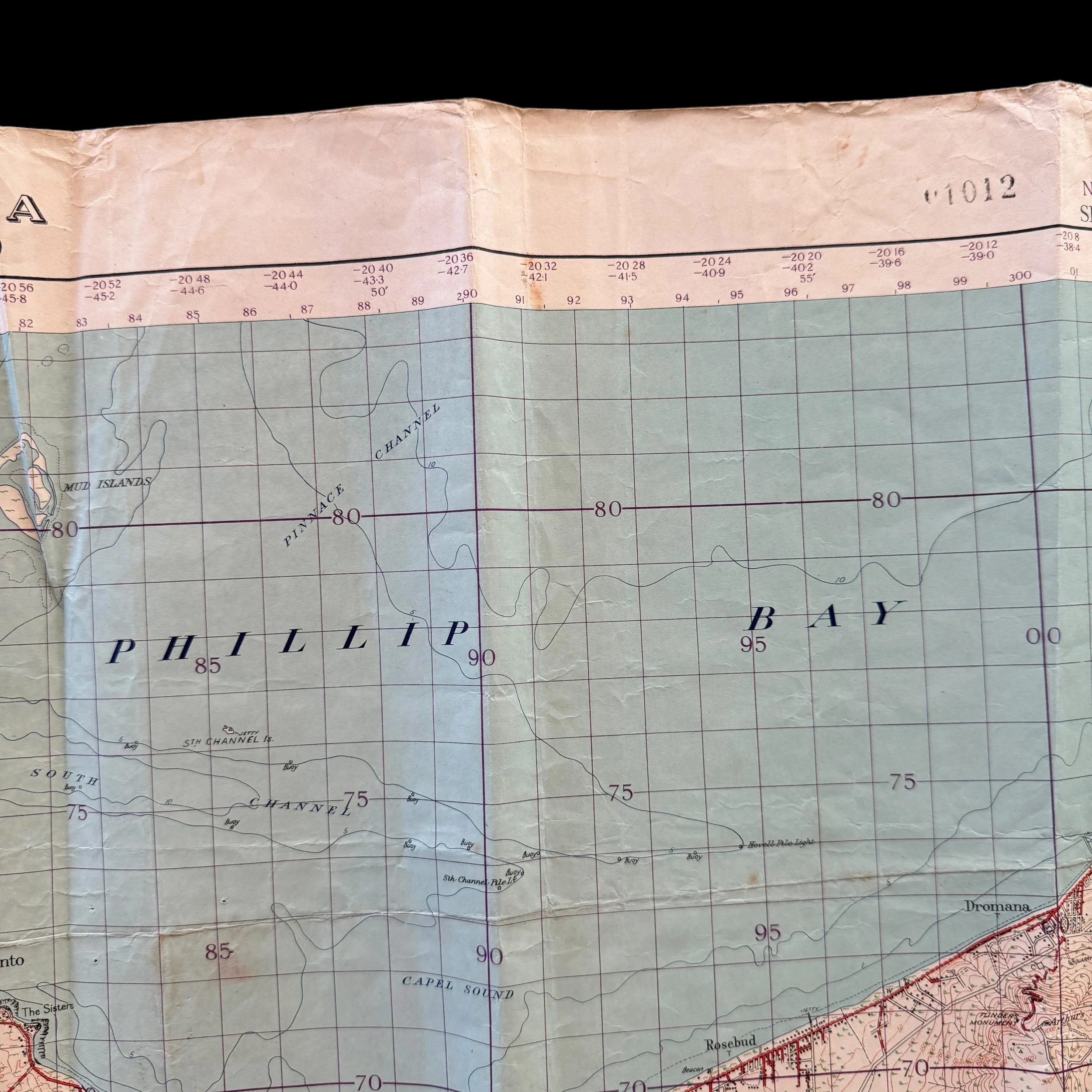
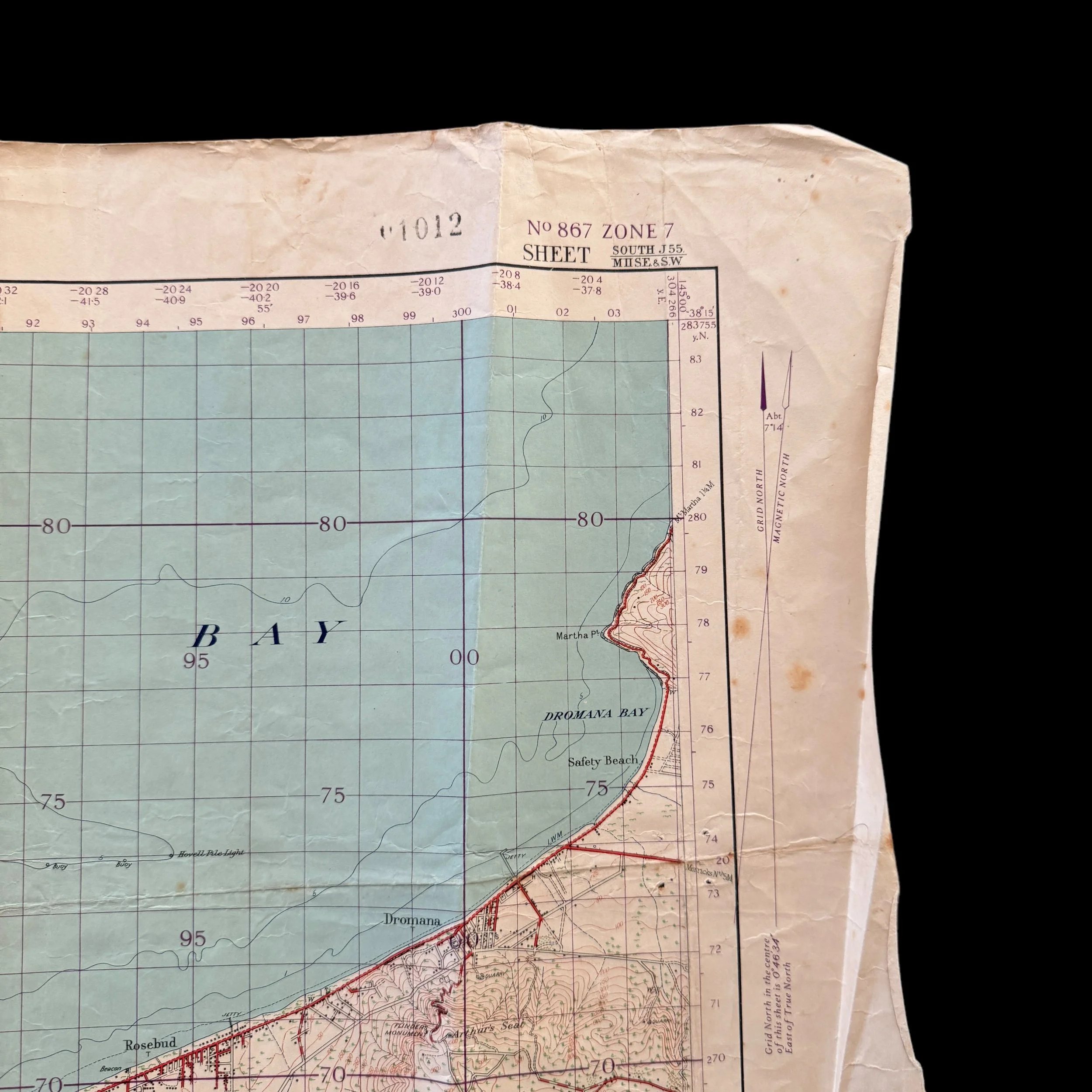
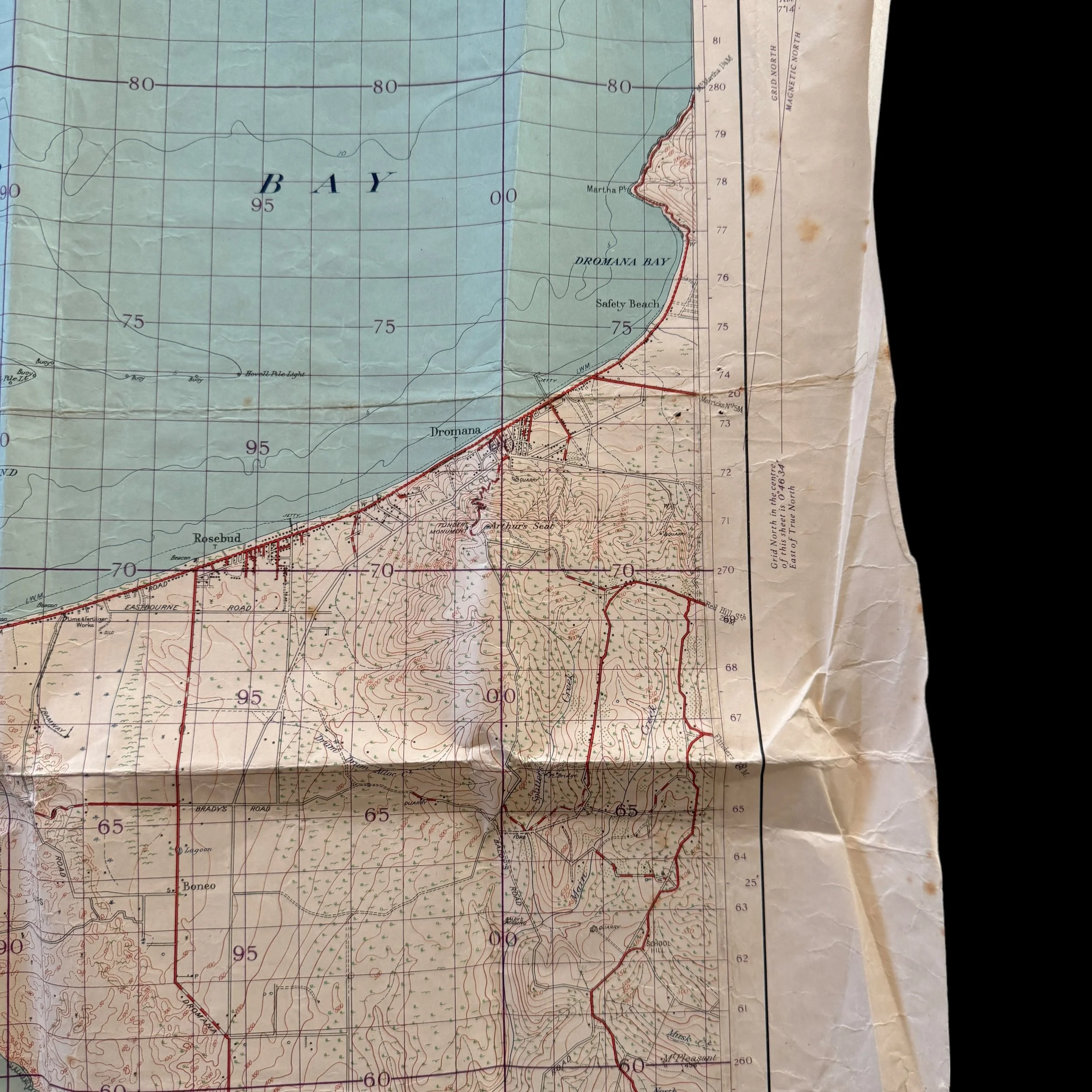
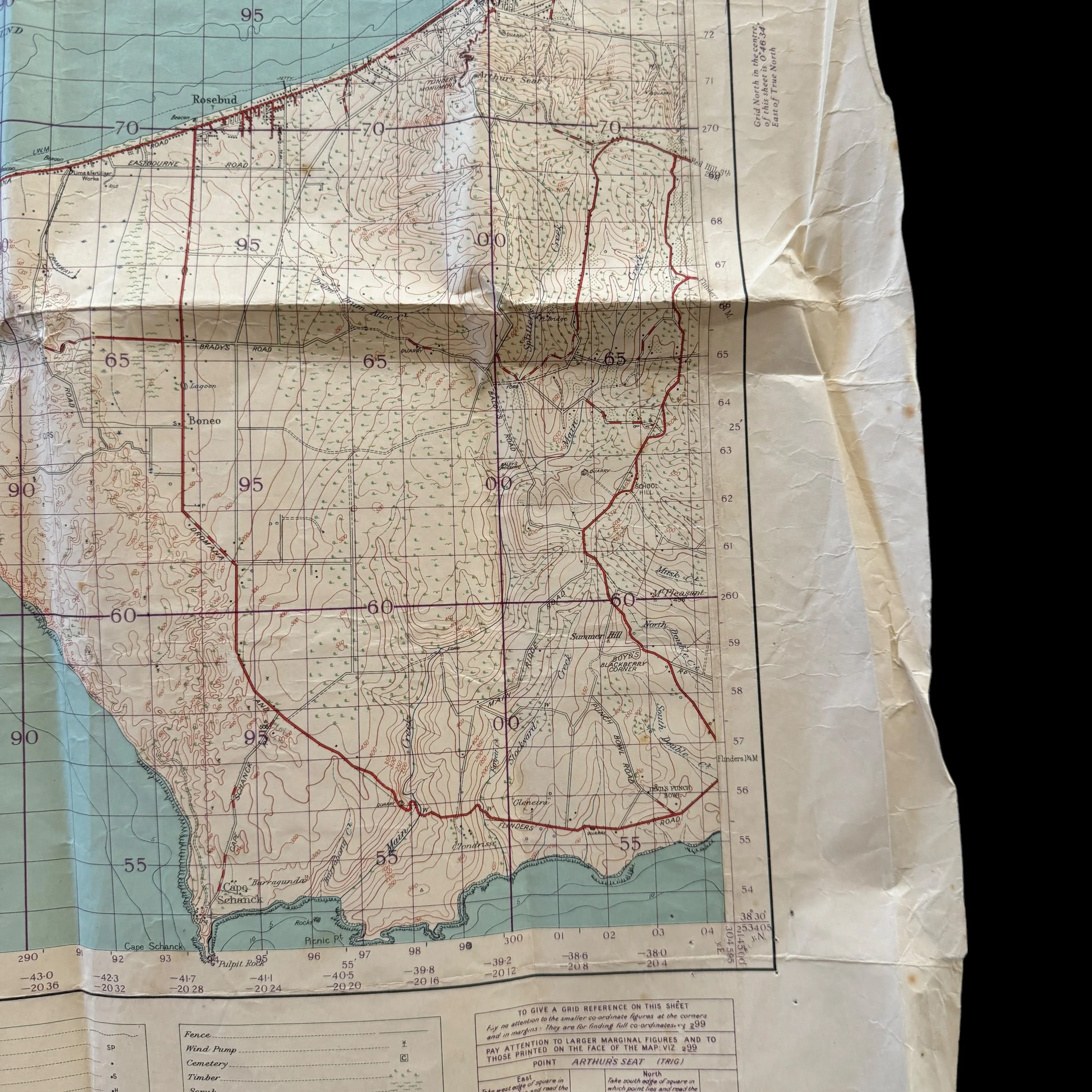
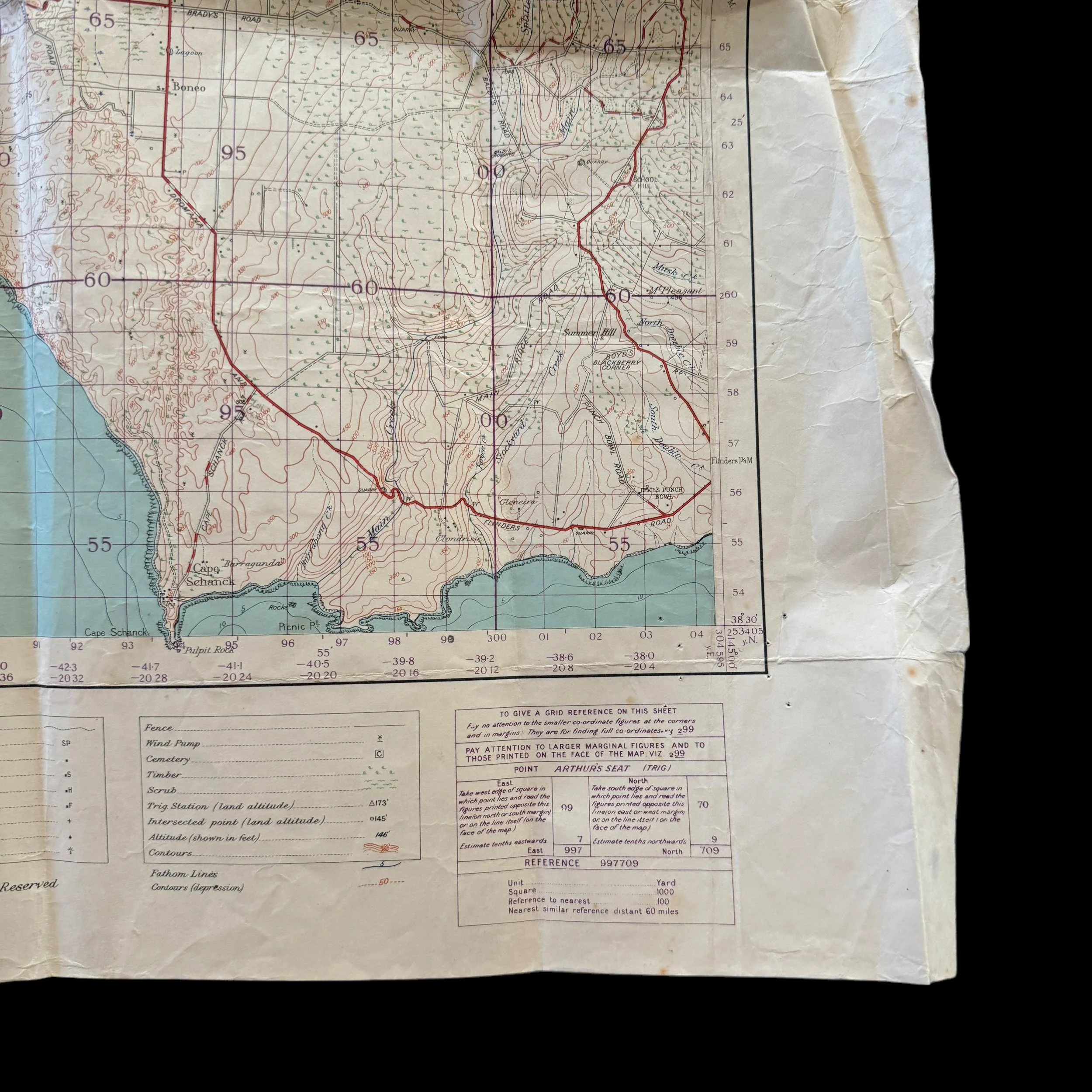
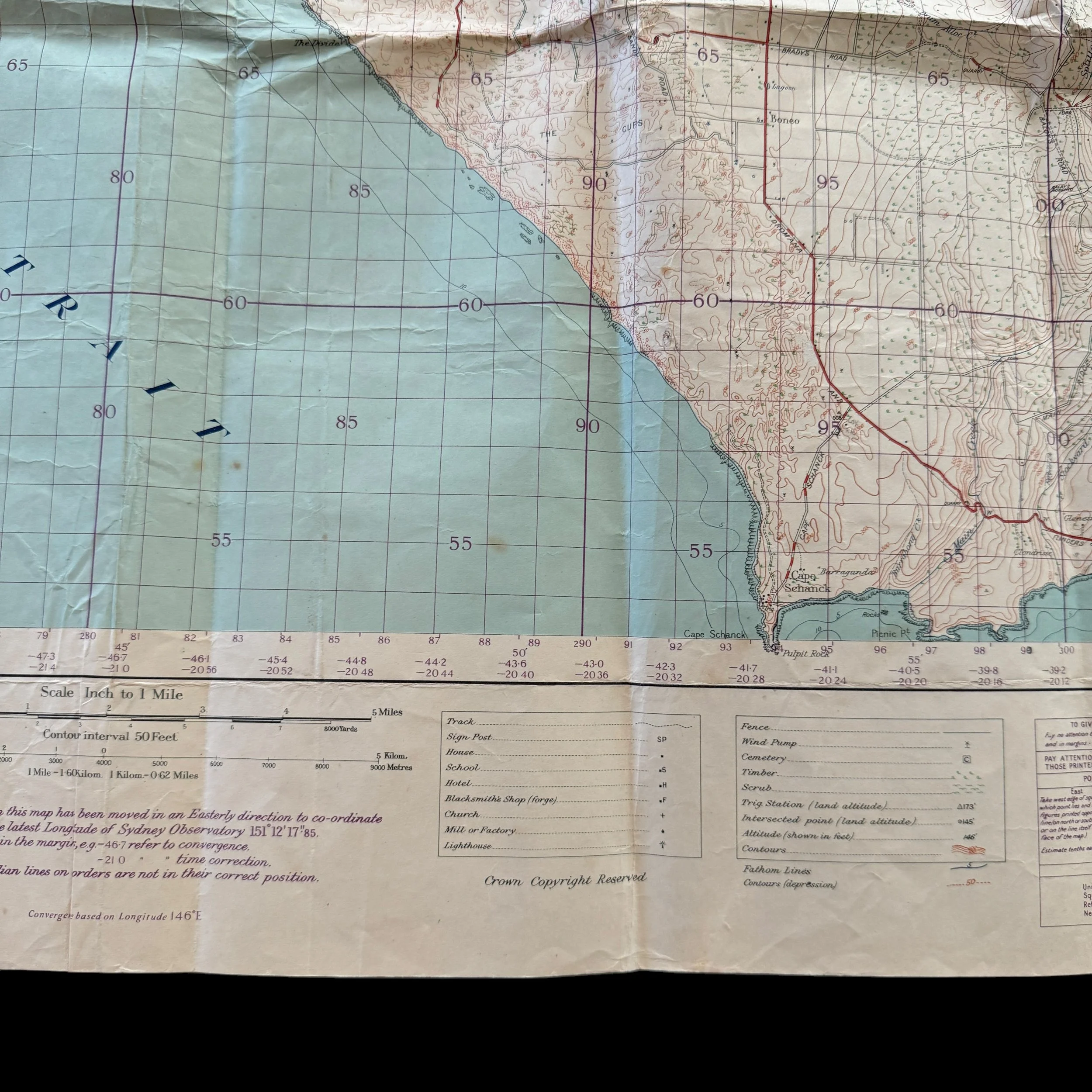

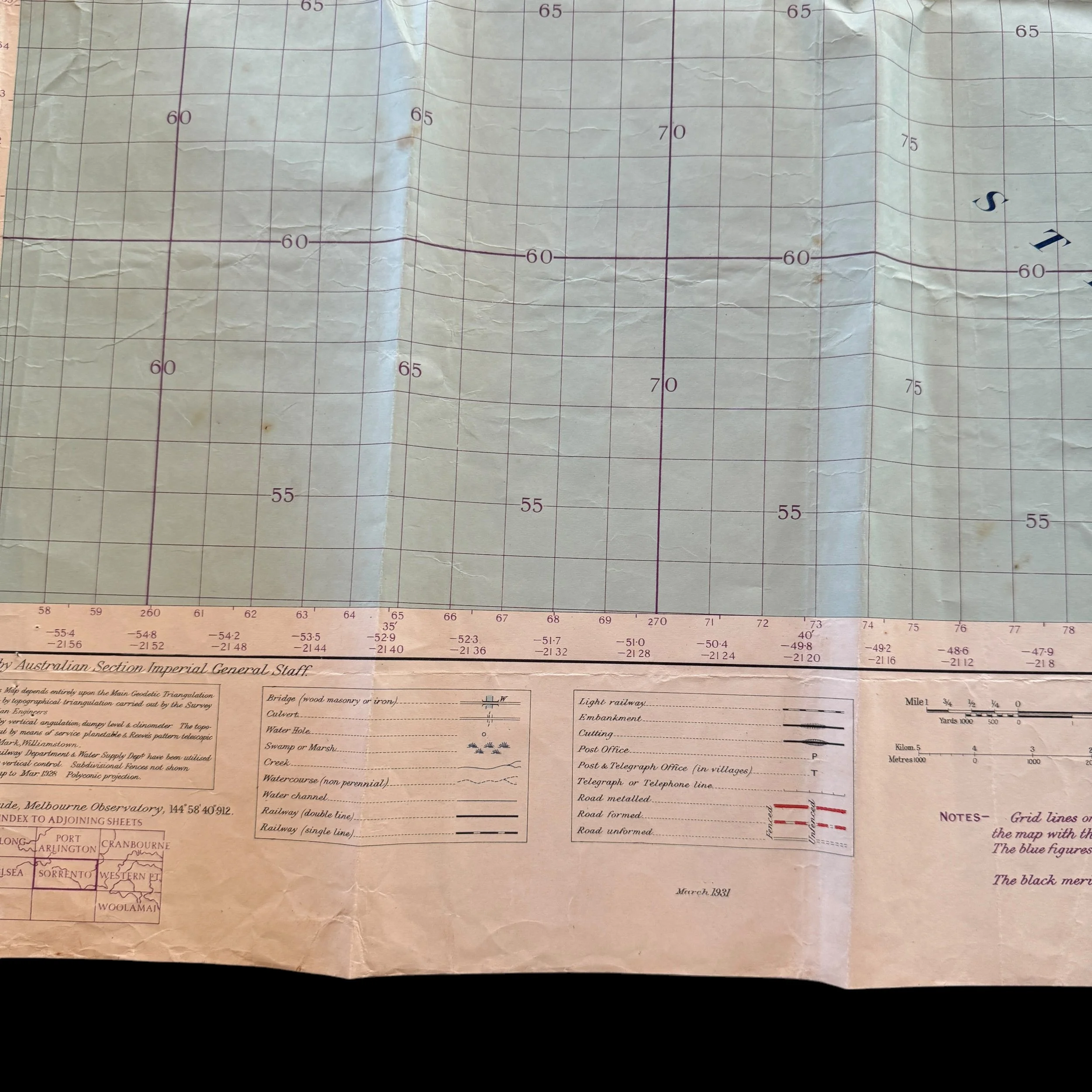
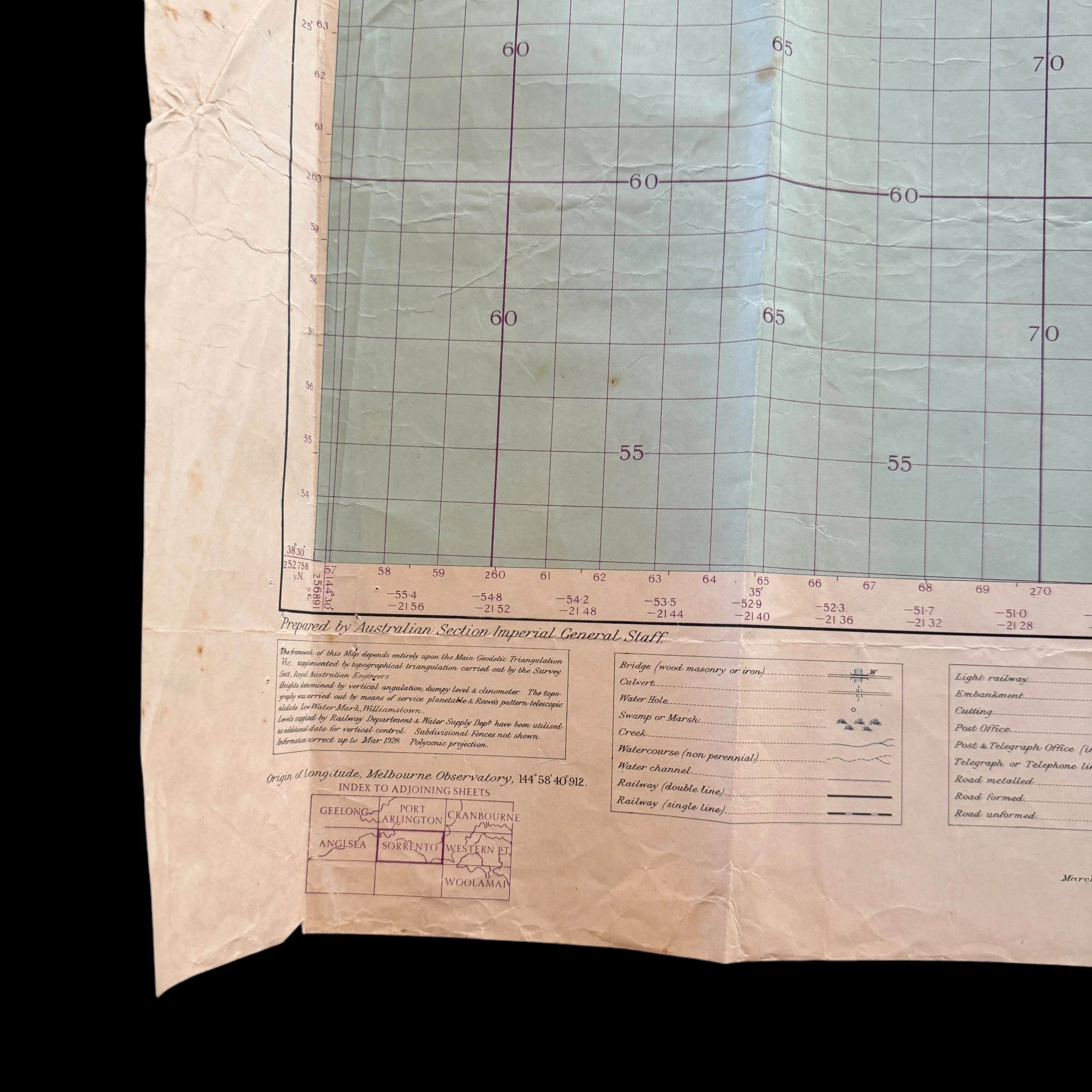

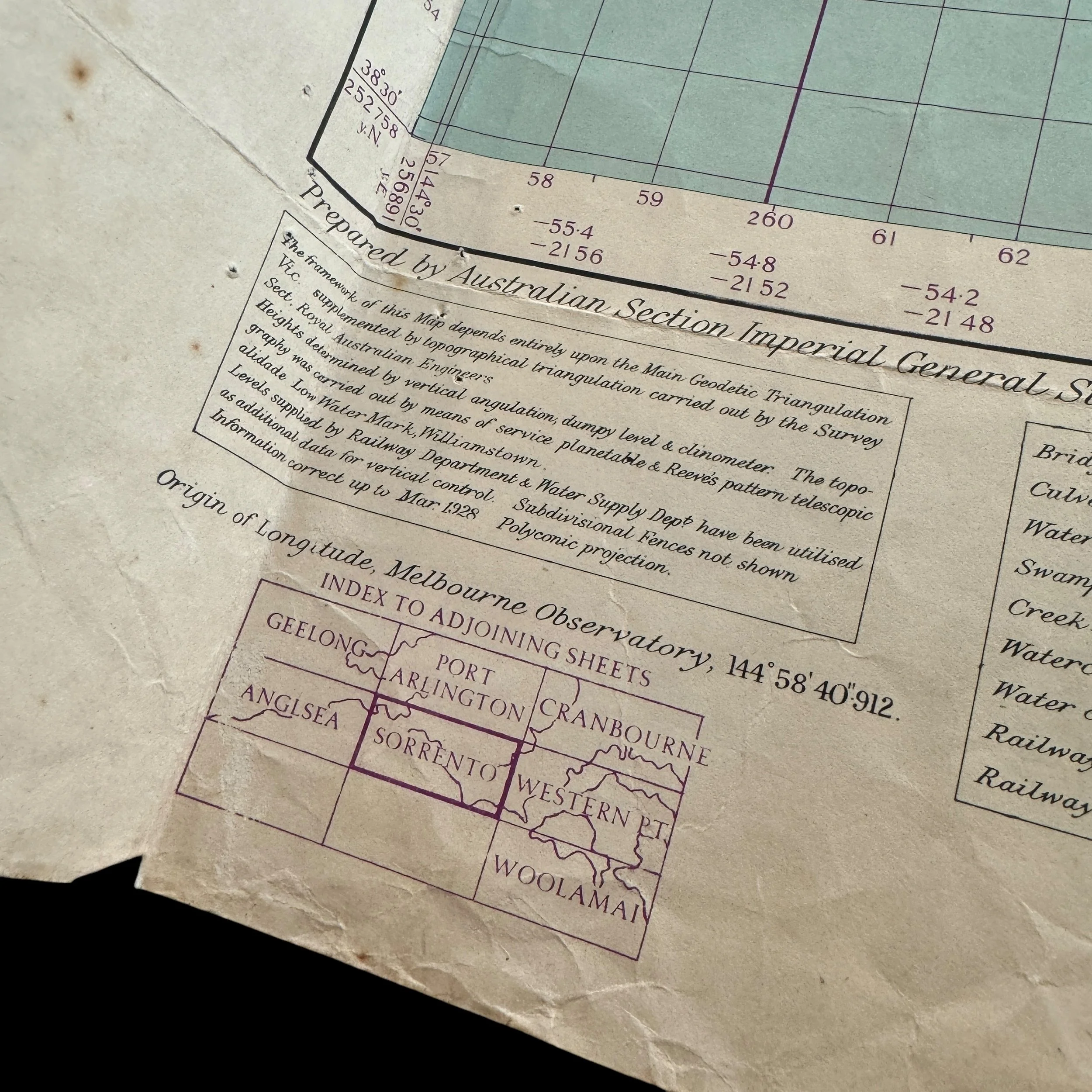
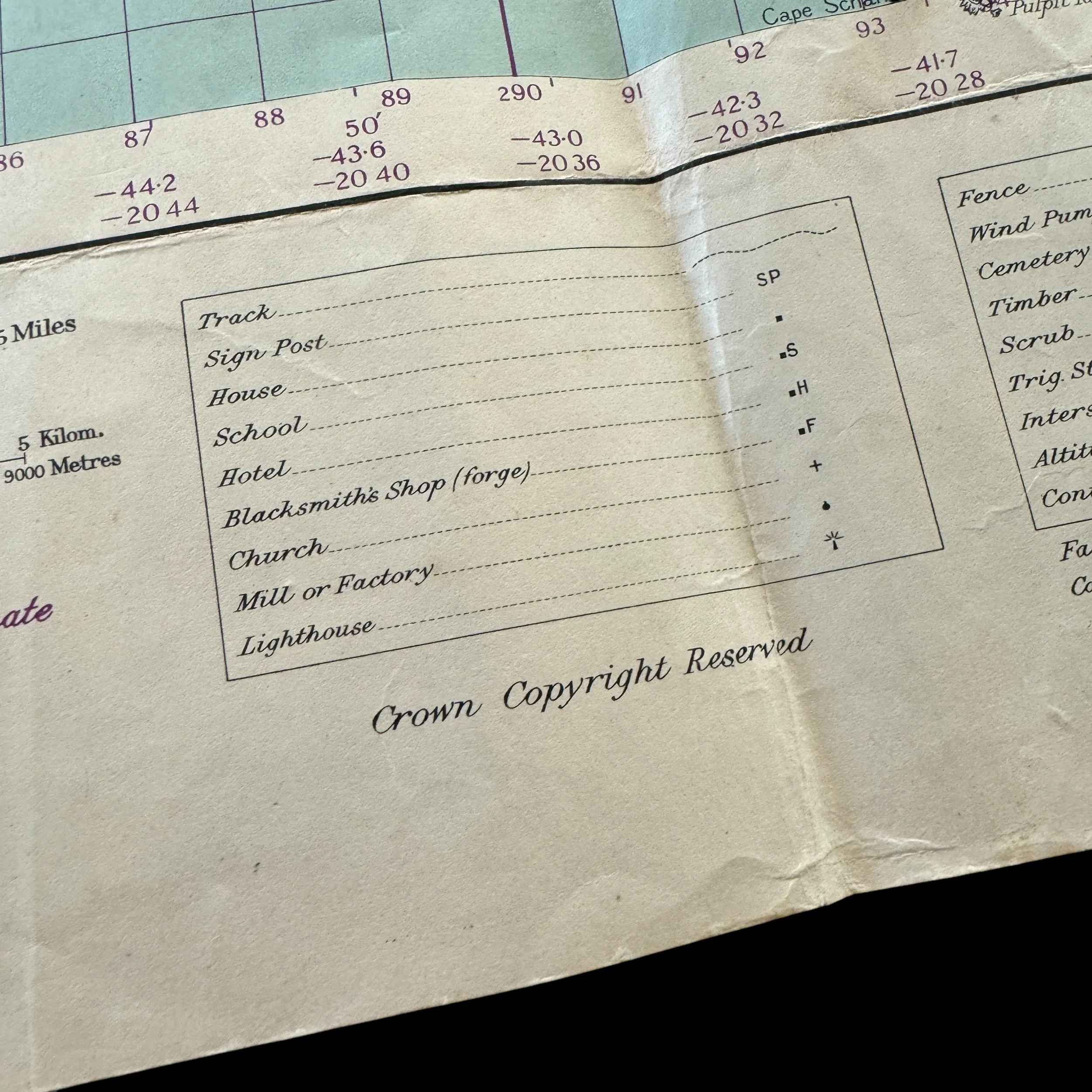
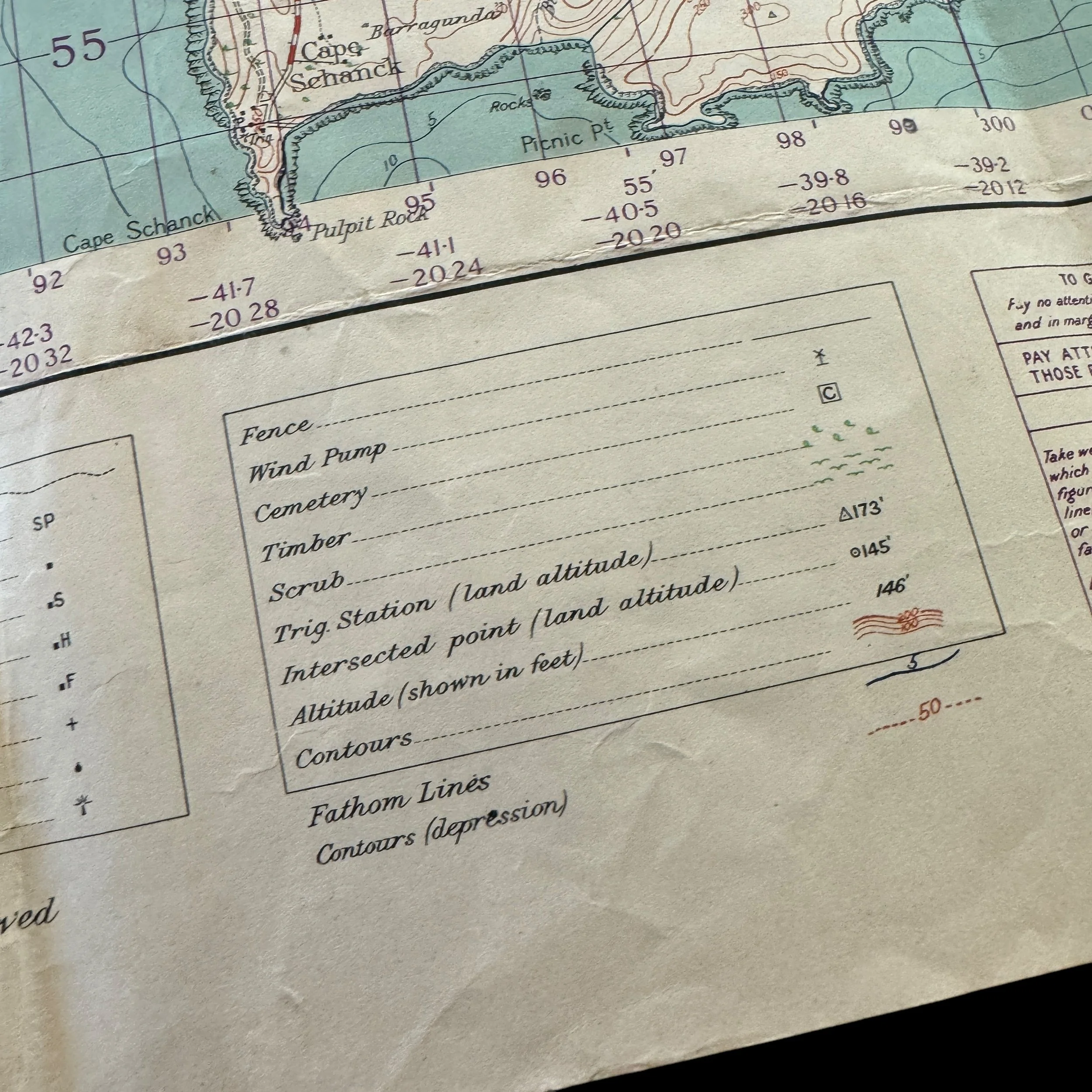
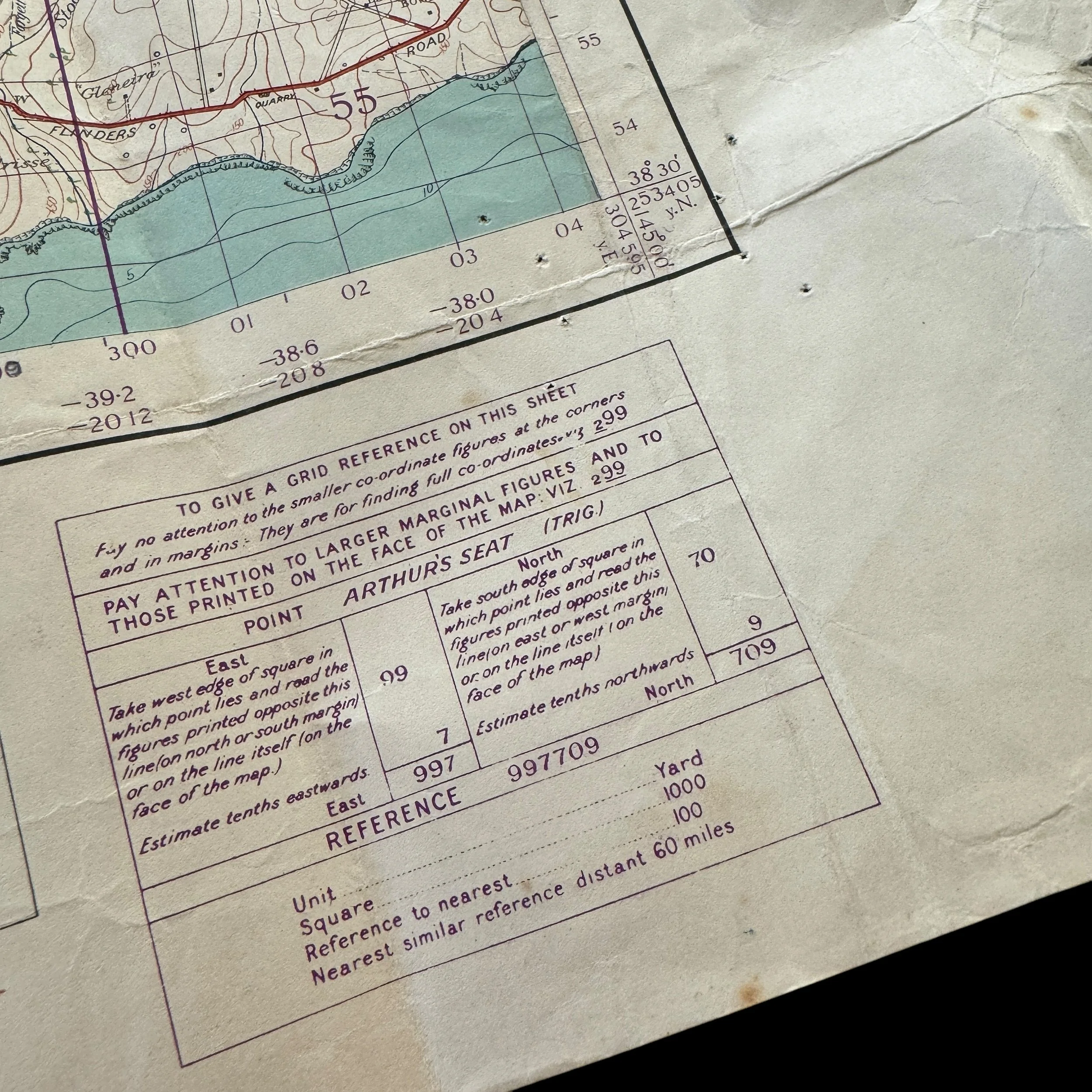



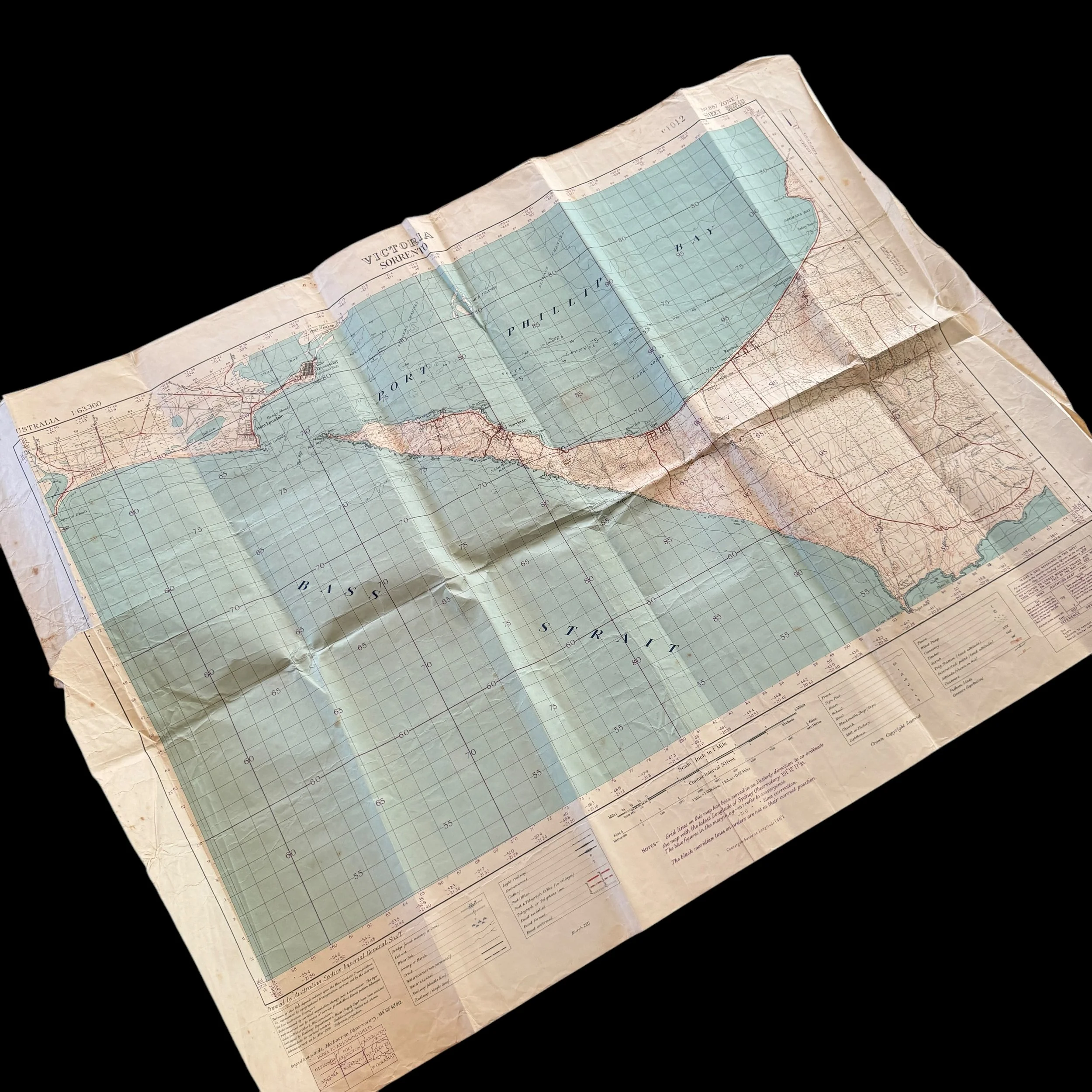
WWII Allied Land Force Headquarters (LHQ) "Victoria - Sorrento" Australia Mainland Operations Map*
Comes with a hand-signed C.O.A.
This rare and museum-grade WWII artifact is an original Allied Land Force Headquarters (LHQ) Australia map that was used by LHQ Allied military forces based in Australia during the height of operations in the Pacific Theater. This map comes directly from a WWII bring-back collection of an Australian LHQ “Tactical Division” serviceman who saved a large collection of maps utilized by the LHQ during his WWII service in Australia.
Australia, facing the threat of a Japanese invasion in early 1942, required precise mapping to safeguard its vast coastline and establish defensive strategies. Following the fall of Singapore and Japanese bombing raids on Darwin, the LHQ prioritized the creation and distribution of detailed topographical maps of the Australian mainland, especially of coastal regions and key urban centers. These maps allowed commanders to assess where potential landings by Japanese forces might occur and to plan the defense of these areas.
As the tide of the war shifted and the Allies moved from a defensive stance to offensive operations, maps of Australia continued to be a critical resource for the LHQ in supporting campaigns in New Guinea, the Solomon Islands, and later Borneo. While Australia itself was not the site of major battles, it served as a vital staging ground, and maps were used to plan logistical support for operations
During World War II, the Allied Land Force Headquarters (LHQ) in Australia relied heavily on maps to coordinate operations, make strategic decisions, and navigate the challenging terrain of the Pacific theater. Maps played an essential role in planning both defensive and offensive operations, particularly as Australia served as a crucial base for Allied forces in the South West Pacific Area (SWPA). The use of maps was a cornerstone of military logistics, intelligence gathering, troop movements, and planning amphibious assaults across the vast region. In this context, maps of Australia and surrounding areas were indispensable tools for the LHQ, helping to ensure the effective management of operations.
LHQ Strategic Planning and Defensive Operations
Australia, facing the threat of a Japanese invasion in early 1942, required precise mapping to safeguard its vast coastline and establish defensive strategies. Following the fall of Singapore and Japanese bombing raids on Darwin, the LHQ prioritized the creation and distribution of detailed topographical maps of the Australian mainland, especially of coastal regions and key urban centers. These maps allowed commanders to assess where potential landings by Japanese forces might occur and to plan the defense of these areas.
The strategic use of maps allowed the LHQ to:
Identify Potential Invasion Points: With Australia's lengthy coastline, maps were crucial for identifying the most vulnerable and likely points of a Japanese invasion, such as in northern and eastern Australia. Maps provided information on the geography of these areas, including natural barriers like mountains and forests, as well as the proximity of railways and roads necessary for the quick movement of troops and supplies.
Position Troops and Defenses: Once the LHQ identified vulnerable regions, maps were used to position defensive units, artillery, and anti-aircraft defenses. Fortifications were planned around key cities such as Darwin, Brisbane, and Sydney, as well as around vital transportation hubs. Maps allowed LHQ commanders to allocate resources efficiently, ensuring adequate coverage of strategic areas.
Coordinate Air and Naval Operations: In addition to land-based defenses, maps were used to coordinate airfields and naval installations across Australia. This was particularly important for establishing air and naval superiority in the region, with maps showing the locations of critical airfields and ports, enabling seamless communication between the different branches of the military.
Infrastructure Assessment: The LHQ had to ensure that critical infrastructure—roads, railways, and ports—could support the movement of troops, supplies, and equipment. Detailed maps allowed military engineers to evaluate the condition of infrastructure and plan improvements to ensure efficient logistics. Additionally, air reconnaissance was used to update maps, ensuring the most accurate and current information for planning and operations.
Offensive Operations and Forward Planning
As the tide of the war shifted and the Allies moved from a defensive stance to offensive operations, maps of Australia continued to be a critical resource for the LHQ in supporting campaigns in New Guinea, the Solomon Islands, and later Borneo. While Australia itself was not the site of major battles, it served as a vital staging ground, and maps were used to plan logistical support for operations conducted from Australian bases.
Staging and Deployment of Troops: Australia was the launching point for many of the Allied campaigns in the Pacific, and maps were used to plan the staging and deployment of troops from bases in Australia to the front lines. For example, large troop movements from bases in Queensland, such as Townsville, to the campaign in New Guinea required precise planning. Maps were used to determine the best routes for transportation by sea and air, identify safe harbors for naval convoys, and establish supply lines from Australia to the combat zones.
Mapping Supply Chains: As operations expanded into the islands of the South West Pacific, the LHQ relied on maps to ensure that supply lines from Australia remained open and efficient. This included planning the shipment of food, ammunition, medical supplies, and reinforcements. By analyzing maps of Australia’s ports and transportation infrastructure, the LHQ could determine the best routes for transporting materials to front-line bases and island garrisons.
Amphibious Assaults and Island Hopping: The LHQ played a significant role in planning amphibious assaults in the Pacific. While many of these operations took place far from Australian shores, Australia was often the site of the initial planning and staging of these operations. Maps were essential for planning amphibious landings, and Australian cartographers and intelligence officers produced detailed maps of island terrain based on aerial reconnaissance and intelligence reports. These maps were used in training exercises in Australia before troops were deployed to the battlefield.
Intelligence and Cartographic Updates
Throughout the war, maps of Australia and the surrounding areas were continuously updated with new intelligence and reconnaissance data. Aerial reconnaissance, in particular, played a critical role in gathering information on enemy movements and updating maps accordingly. Cartographers at the LHQ would update maps based on this information, which allowed commanders to make informed decisions based on the latest intelligence.
The process of updating maps involved several key components:
Aerial Reconnaissance: Aircraft were used to gather visual and photographic intelligence of enemy positions, infrastructure, and troop movements. These reconnaissance flights provided the LHQ with valuable data, which was then incorporated into maps for operational planning. This helped to keep the maps accurate and relevant to the constantly changing battlefield environment.
Coastal and Riverine Navigation: Many operations required detailed maps of coastlines and river systems to facilitate naval and amphibious operations. Cartographers used intelligence from naval operations to produce maps that detailed hazards, such as reefs and shoals, that could impact naval convoys. Additionally, these maps helped plan river crossings or amphibious landings in campaigns such as the Borneo operation in 1945.
Tactical and Strategic Maps: The LHQ utilized both strategic-level maps, which provided a broad overview of the entire theater of operations, and tactical-level maps, which focused on specific regions or battlefields. Tactical maps were used by field commanders to plan immediate operations, while strategic maps helped high-level planners at the LHQ coordinate broader campaigns across the SWPA.
Collaboration with Allied Forces
Maps of Australia were also shared and coordinated with Allied forces, particularly with the United States military, which had a significant presence in Australia throughout the war. General Douglas MacArthur, as the Supreme Commander of Allied Forces in the SWPA, relied on the LHQ for the production and distribution of maps, both for defensive planning and for planning the various Pacific offensives.
The LHQ worked closely with the U.S. military to ensure that maps used by both Australian and U.S. forces were standardized and accurate. This coordination extended to naval and air operations as well, with maps produced by the LHQ being used for joint operations, such as the Battle of the Coral Sea and the subsequent campaigns in the Solomon Islands and New Guinea.
The Allied Land Force Headquarters in Australia made extensive and strategic use of maps during World War II to plan and execute military operations. From organizing defensive strategies along Australia's coastlines to coordinating complex offensive operations in the Pacific, maps were essential tools for the LHQ. They facilitated the effective movement of troops and supplies, ensured the accuracy of intelligence, and allowed commanders to make informed decisions in a constantly evolving conflict. The LHQ's use of maps was a key factor in the successful defense of Australia and the eventual Allied victory in the Pacific theater.
____________________
The Allied Land Force Headquarters (LHQ) Australia During WWII: A Comprehensive Overview
The Allied Land Force Headquarters (LHQ) in Australia played a pivotal role in the Pacific theater during World War II, coordinating military strategies, operations, and logistics for the Allied forces, particularly in the South West Pacific Area (SWPA). Its establishment and operations were crucial in facilitating the effective management of the complex and dynamic war effort in this region. The LHQ served as the nerve center for the strategic planning and execution of ground operations, supporting the defense of Australia, and conducting offensive operations against the Japanese forces. To understand the significance of the LHQ during WWII, it is important to explore its origins, structure, leadership, key operations, and its overall impact on the war effort.
Origins and Formation
The creation of the Allied Land Force Headquarters in Australia was driven by the need to coordinate and streamline the efforts of multiple military forces engaged in the Pacific conflict. Following the outbreak of hostilities in the Pacific in December 1941, the rapid advance of Japanese forces posed a serious threat to Australia and its neighbors. The fall of Singapore in February 1942 and the Japanese bombing of Darwin later that month brought the war to Australia's doorstep. As the Japanese forces extended their control over much of Southeast Asia and the Pacific islands, the need for a unified and effective military command structure in Australia became apparent.
In response to this threat, the LHQ was established in early 1942, with the primary goal of overseeing the land-based military operations of the Allied forces in the SWPA. This command structure was part of the larger Allied command arrangement that included the U.S., Australia, New Zealand, and other Allied nations working together to combat the Japanese advance. The LHQ was initially based in Melbourne, but later relocated to Brisbane to be closer to the SWPA theater of operations.
Structure and Leadership
The LHQ was led by the Commander-in-Chief, General Sir Thomas Blamey, who was appointed in 1942. Blamey was a highly experienced Australian officer, having served in World War I and as the Deputy Chief of the General Staff during the interwar period. His leadership was instrumental in the coordination of the Australian Army and other Allied ground forces in the Pacific theater. Blamey worked closely with General Douglas MacArthur, who was the Supreme Commander of the SWPA. While MacArthur held overall command of the Allied forces in the region, Blamey was responsible for directing land operations.
The LHQ's structure was complex, reflecting the multifaceted nature of the war in the Pacific. It included various operational divisions responsible for planning, intelligence, logistics, communications, and training. The headquarters was staffed by Australian and Allied officers, including senior commanders from the U.S. and other nations. This joint command structure ensured that operations were coordinated across national boundaries and military branches, a necessity given the multinational composition of the Allied forces in the SWPA.
Blamey's leadership was not without controversy. He faced criticism from some quarters for his handling of certain operations, particularly in New Guinea, where the Australian forces suffered significant losses. However, Blamey's ability to maintain cohesion among the Allied land forces and his experience in managing large-scale military operations were invaluable to the overall success of the Allied campaigns in the Pacific.
Key Operations and Campaigns
The LHQ was involved in numerous critical campaigns throughout the Pacific theater during WWII, most notably in New Guinea, the Solomon Islands, and the Borneo campaign.
The New Guinea Campaign
One of the most significant operations overseen by the LHQ was the defense and subsequent counteroffensive in New Guinea. The Japanese sought to capture Port Moresby, which would have provided them a base for further operations against Australia. The Battle of the Coral Sea in May 1942 thwarted their seaborne invasion attempt, but the Japanese then attempted to take Port Moresby by land via the Kokoda Track.
The LHQ, under Blamey's command, played a crucial role in directing the defense of New Guinea, which became one of the fiercest campaigns of the Pacific War. Australian troops, many of them inexperienced militia forces, fought valiantly in the grueling conditions of the Kokoda Track, eventually halting the Japanese advance. The LHQ coordinated the reinforcement and resupply of these troops, despite the logistical challenges posed by the terrain and the enemy's control of the seas and skies.
Following the successful defense of Port Moresby, the LHQ oversaw the subsequent Allied offensives in New Guinea, including the Battle of Buna-Gona and the Huon Peninsula campaign. These operations were essential in driving the Japanese forces out of New Guinea and securing the northern approaches to Australia. The LHQ's role in planning and executing these operations demonstrated its importance in the overall Allied strategy in the SWPA.
The Solomon Islands Campaign
The LHQ also contributed to the Allied operations in the Solomon Islands, a key theater in the broader strategy of isolating and defeating Japanese forces in the Pacific. The campaign began with the U.S. Marines' landing at Guadalcanal in August 1942, but Australian forces played a critical supporting role in subsequent operations in the Solomon Islands.
The LHQ coordinated Australian ground forces that participated in the fighting on Bougainville and other islands in the Solomons. These operations were part of the larger effort to cut off Japanese forces in the region from their supply lines and prevent them from reinforcing their positions in New Guinea and the Philippines. The LHQ's effective management of Australian forces in these campaigns contributed to the eventual Allied victory in the Solomon Islands, which helped turn the tide of the war in the Pacific.
The Borneo Campaign
The final major operation overseen by the LHQ was the Borneo campaign, which took place in the closing stages of the war in 1945. This campaign was designed to liberate the island of Borneo from Japanese occupation and secure the valuable oil resources located there. Australian forces, under the direction of the LHQ, played a leading role in the amphibious landings and subsequent fighting in Borneo.
The Borneo campaign demonstrated the LHQ's ability to plan and execute complex joint operations involving land, sea, and air forces. The successful liberation of Borneo further weakened the Japanese position in Southeast Asia and hastened the end of the war.
Coordination with Allied Forces
The LHQ's success during WWII was due in large part to its ability to effectively coordinate with Allied forces, particularly the United States. General Douglas MacArthur's headquarters in Brisbane worked closely with Blamey's LHQ to ensure that land operations were integrated with naval and air operations. This close cooperation was essential in the SWPA, where the vast distances and difficult terrain required careful planning and coordination.
One of the most notable aspects of this coordination was the ability of the LHQ to adapt to the evolving nature of the war. As the Allies shifted from a defensive posture to an offensive one, the LHQ played a key role in ensuring that land forces were adequately supplied, trained, and equipped for the challenges of amphibious warfare and jungle fighting.
Legacy and Impact
The Allied Land Force Headquarters in Australia left an enduring legacy in both the military history of Australia and the broader history of WWII. Its role in defending Australia and supporting Allied offensives in the Pacific was critical to the eventual defeat of Japan. The LHQ demonstrated the importance of joint command structures in modern warfare, where the effective coordination of land, sea, and air forces is essential for success.
Moreover, the LHQ's operations during WWII helped to cement Australia's place as a key player in the Allied war effort. Australian forces, under the direction of the LHQ, played a vital role in some of the most challenging and decisive campaigns of the Pacific War, from the defense of New Guinea to the liberation of Borneo.
In conclusion, the Allied Land Force Headquarters in Australia was a crucial element of the Allied command structure in the SWPA during WWII. Its leadership, planning, and execution of key operations helped to turn the tide of the war in the Pacific and secure victory for the Allies. The LHQ's legacy endures as a testament to the importance of effective military coordination and the vital role that Australia played in the global conflict of WWII.